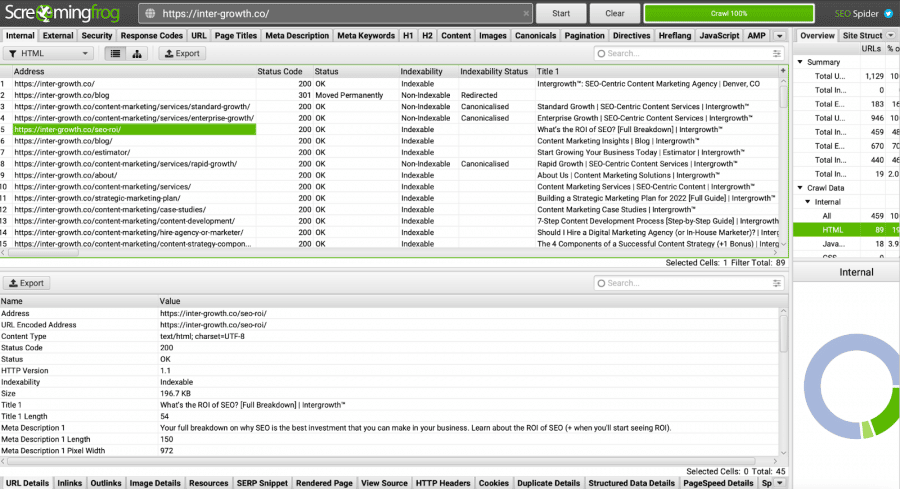When it comes to finding information online, it’s all about SEO.
We know it’s an acronym you’re sick of hearing. Yet there’s a reason why “SEO” appears in over 1.4 billion Google search results:
Businesses and individuals alike recognize how important it is.
All your competitors use SEO techniques on their websites.
Without an SEO strategy in place, you’re not even in the game. You’re allowing the competition to acquire customers that could be yours. They’re building a more recognizable brand for themselves while leaving you in the dust.
It’s time you put your own SEO strategy in place.
That starts with building an SEO foundation.
Will reading this article make you an SEO expert overnight?
Not likely, but it will equip you with the fundamental knowledge you need to master search engine optimization.
Let’s get into the core elements of building a solid SEO foundation for your business.
Every Website Needs a Strong SEO Foundation
The purpose of search engine optimization is to improve your rankings in search engine result pages.
And do you know how search engines determine which pages reach the top of the SERPs?
With a series of algorithms.
Don’t waste your time trying to crack the algorithms — the Google gods are the only ones that know exactly what’s written into that code. What you need to focus on is search positioning your website to attract the right audience and provide them with the information they’re seeking.
SEO helps Google navigate your website and decide where in search results to list your page.
But it’s not about getting a first page ranking for a random keyword or phrase. It’s about search positioning upon a core theme that you then optimize your site around.
Search positioning is a way to develop your SEO techniques based on:
- Core descriptors of your brand
- Target audience you want to attract
- Content that will increase organic traffic and lead to conversions
With the right search positioning strategy in place you can draw traffic to your website through organic searches and inform search engines of the intent of your website.
This guide dives into the SEO principles of Relevancy and Crawlability. Learn more about the 3 Principles of SEO here.
1. Equip Yourself With SEO Tools
Having an SEO strategy in place isn’t enough. You also need tools that make it possible to execute that plan.
Here’s a look at some of the most effective SEO tools that exist and how they can help you climb to the top of the list in search results.
Google Search Console
Google Search Console is free, so there’s no good reason not to use it.
With Google Search Console you can:
- See how often your site appears in Google searches
- Show which sites are backlinking to your site
- Request re-indexing of new content and updated content
- Monitor your website rankings
Google Analytics & Bing Webmaster Tools
With a Google Analytics account you can see how every visitor to your site interacted with a particular page. It’s also a way to see conversion rates and identify where each site visit originated from, such as a search engine result, an advertisement, or an email.
Bing Webmaster Tools is a similar equivalent that measures your performance in Bing search engine results.
SEMRush
Not sure what the search positioning for your website should be?
SEMRush can help you figure that out.
With SEMRush SEO tools you can:
- Identify the best, most relevant keywords for your brand
- Improve local SEO strategies to acquire more local customers
- Analyze your competitors’ websites and content
- Identify opportunities for link building
- Track the rankings of your keywords
In addition to SEO tools, SEMRush offers dozens of other tools and reports that help you perform market research, advertise your business, build brand awareness, and generate more organic traffic to your site.
Ahrefs
Ahrefs is a comprehensive suite of SEO tools that make it easy to:
- Identify keywords that you can rank for in global search engines
- See which pages are ranking at the top of search result
- Analyze SERP history
- See all of the backlinks to your website
- Check for broken backlinks
- Keep track of external links
- Identify guest blogging opportunities
- Identify gaps in your content
Whether you’re an SEO expert or are about to dip your toe into the SEO pool for the first time, Ahrefs is one of the most important tools you can have in your arsenal.
Screaming Frog
The Screaming Frog SEO spider crawls your website to help you identify where you can improve upon SEO.
With Screaming Frog you can:
- Analyze page titles and meta data
- Find broken links and server errors
- Identify duplicate content
- Evaluate internal links
- Track your SEO progress
This screenshot shows some of the valuable information you can learn with a Screaming Frog website crawl:

Discover more SEO tools in: DIY SEO Tools for Do-It-Yourself Content Marketers
2. Learn How to Research Keywords
To optimize your pages for SEO, you’ll need to determine which keyword themes you’re going to optimize for.
At the same time, you’ll need to decide on the themes you plan to optimize your site around.
Here’s how to tackle this:
- Start by mapping out the core search themes that you want to rank for long-term.
- Then determine whether or not you already have pages on your site that focus on ranking for those themes.
If you do, you can update those pages with search-optimized content.
If you don’t, you’ll want to create a dedicated resource, such as a blog article or a case study, that focuses on that theme.
Once you pick your themes it’s time to research keywords that are relevant to those themes. Keywords can be individual words (target keywords) as well as strings of words or phrases, referred to as long-tail keywords.
You can do keyword research with any number of SEO tools, including:
- SEMRush
- Ahrefs
- Google Search Console
- Google Keyword Planner
Each tool works in varying ways, but they are all easy to use, even for non-tecchies that are brand new to SEO.
Once you know the keywords to use, incorporate them into your content in a natural way. Google penalizes sites that use keyword stuffing tactics.
More on the keyword research process that we use to build industry leaders.
3. Optimize On-Site Pages
On-site SEO, also referred to as on-page SEO, means optimizing specific elements of every page on your website.
In addition to optimizing your content, optimizing the following six elements helps humans and search engines know what your page is all about.
Meta Titles
The meta title of a page, also called the title tag, tells people what they can expect from the page when it appears in Google search results. Whenever possible, include your target keyword in the title.
Meta Descriptions
The meta description is that little blurb that appears beneath your title tag in search results. This is an opportunity to give a bit more information about what readers can expect from your page, and it should also include your target keyword.
Ecommerce sites and businesses selling services should also include a call to action to encourage potential customers to click.
H1-H6 Tags
You can break up sections of content within a web page by using H1, H2, H3, and other header tags.
- Your H1 tag is your main header, and it should include your target keyword.
- H2 tags indicate subheadings for the main content sections of your page.
- H3 tags are a way to further break down sections of content within an H2 tag.
For lengthy, detailed pieces of content, you can break sections down even further by using H4, H5, and H6 tags.
External Links
Linking out to external sites provides a better experience for your reader by pointing them to other valuable resources.
Be sure that any and all outbound links on your site send the reader to the intended page. Since you have no control over what pages other websites move or delete, check the functionality of all of your external links on a routine basis.
Internal Links
While external links can help you get more backlinks, internal links help you keep readers on your website for a longer period of time.
Internal links are links on one web page that redirect readers to a different page within your site. Make sure that all of your internal links work at all times.
URLs
Structure all of your URLs in the same manner. Make them readable with words as opposed to numbers and symbols, and keep them short.
A short, concise URL is yet another way for Google to know what your page is about.
(Advanced) Use Content Optimization Software
One of the best tools for optimizing on-page SEO is Clearscope.
Clearscope uses a statistical analysis method known as term frequency, inverse document frequency (TF-IDF) to uncover themes related to the search queries your page attempts to rank for.
From there, you can audit a page to identify concepts you should incorporate into an updated version of the page to provide a more valuable resource for readers (and rank higher in search results).
Related: How to Choose an SEO Agency that Can Provide Guidance and More
4. Use SEO Techniques to Enhance Your Content

The single best way to draw traffic to your website is with great content.
That holds true whether your business goal is to sell more products or build personal brand awareness as a blogger or influencer.
Knowing all the SEO tricks that exist isn’t enough to get you to the top results on Google or Bing.
The first criteria for ranking high is well-written content that’s created with the user experience in mind. That means you’ll need to have a solid content marketing strategy in place as well as an actionable plan to execute on that strategy.
This starts with understanding user intent.
To understand user intent you must pinpoint your target audience and know what type of information they’re looking for. Then you can develop a content strategy and start utilizing SEO techniques to make your content even better.
5. Optimize for Mobile Devices
According to Statcounter, 58.72% of all web traffic from September 2021 to September 2022 originated from a mobile device. So no matter how great your site looks on your desktop or laptop, make sure it’s optimized for small screens as well.
Many website builders, including the always popular WordPress, allow you to select mobile-optimized themes with responsive design so that your site will scale to fit any screen of any size.
6. Optimize for Technical SEO as Well
Content optimization is only part of the SEO equation. The other part is technical optimization.
For SEO newbies, this is where it can get a bit tricky, but don’t worry — we’re about to give you a list of tools that can do the hard work for you.
Ensure That All Roads Lead to One
The idea of “All Roads Lead to One” is one that we use to audit every site we work on. This approach ensures that all versions of your site redirect to one singular version.
Why?
In order to avoid any duplicate content and maximize your rankings.
Let’s use our page https://intergrowth.com/content-marketing/process/ as an example. This URL is the singular version we want everyone to see. If someone types the address without the SSL certificate, or without the trailing backslash, or with www in the address, they’ll be redirected to this URL instead.
Go ahead and test out these four variations to see what we mean. (You’ll arrive at our singular destination every time).
- https://intergrowth.com/content-marketing/process
- https://intergrowth.com/content-marketing/process/
- https://intergrowth.com/content-marketing/process
- https://intergrowth.com/content-marketing/process/
All Roads Lead to One makes it easier for search engines to analyze your website and prevents your site authority from being diluted across multiple versions of the same page.
Check Your Core Web Vitals
Core Web Vitals are metrics that Google looks at to determine how users experience your page. For a better experience, your site must:
- Load quickly
- Be easy to interact with
- Display stable visuals
Google Search Console provides a Core Web Vitals report that you can use to assess your vitals and improve upon them. You can also use the tool PageSpeed Insights to test the experiences of real users over the past 28 days for any given page on your site or Google Chrome’s Lighthouse report to get a snapshot of how a page performs at this exact moment.
If you find that your Core Web Vitals need improving, here are some steps you might want to take:
- Compress image sizes (Imagify is an excellent tool for this)
- Serve images in next-generation image formats such as WebP and AVIF (this speeds up the rendering of images)
- Prevent non-essential styling elements from loading until the main contents of the page have loaded
For simplicity, we recommend WP Rocket for WordPress websites and Convertly for Shopify websites to do the heavy lifting of these optimizations and much more.
Remove and Fix Broken Links
Let’s be blunt for a second:
Broken links piss people off.
Dead links, broken links, and links that direct to the wrong page are a surefire way to get people to click away from your site.
Take the time to review, remove, update, or fix broken links on a regular basis, including ones you link out to.
Create a Strategic Linking Structure
Every house needs a foundation, and every website needs a structure — a linking structure. A linking structure is a way to group and organize pages on your website. One way to create a linking structure is to build SEO silos.
Building theme-focused silos into your site helps you group related pages together. Silos also make your site appear more relevant to a particular topic, which helps you rank higher for long-tail keywords.
For an in-depth look at building silos, check out this article from Bruce Clay.
Create a Sitemap
A sitemap is a listing of every individual page and file on your website. Sitemaps allow Google to crawl websites and index URLs with ease, which helps boost your rankings in search results.
Most website builders generate one for you. If you hire a web developer to hard code a site from scratch, be sure they create two versions:
- An HTML sitemap for users
- An XML sitemap for search engines
Tools to Improve Technical SEO
For WordPress users, there are lots of tools to help you improve your technical SEO. Some of the ones that we swear by include:
- WP Rocket
- Yoast SEO
- Imagify
- Image Attributes Pro
Read: Affiliate Marketing Tools: The 17+ Tools Every Marketer Needs to learn more about these tools and more.
7. Analyze, Analyze, Analyze
Studying your metrics and analyzing your data is the only way to know if your SEO efforts are working. If you want your website to perform better than your competitors and reach the first page of search results, analyzing the numbers is the best way to do it.
From which pages have the most engagement to high-traffic channels to session duration, an in-depth analysis steers your content strategy toward what’s working and away from what’s not.
In Conclusion
Having a solid SEO foundation is key, and that includes:
- Equipping yourself with SEO tools
- Learning how to research keywords
- Optimizing on-site pages
- Enhancing content with SEO practices
- Optimizing your site for mobile devices
- Optimizing pages for technical SEO
- Analyzing results
SEO is complicated and always evolving. If you can’t devote the time to learning and implementing it, hire a professional to do it for you.
Contact Intergrowth now to learn more about our SEO consulting and SEO-centric content marketing services that can help your business scale and grow with SEO.
SCALE YOUR ORGANIC TRAFFIC
Subscribe to our monthly newsletter





